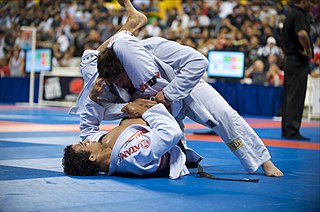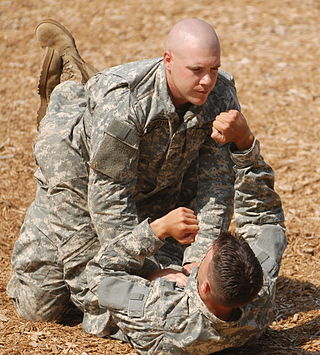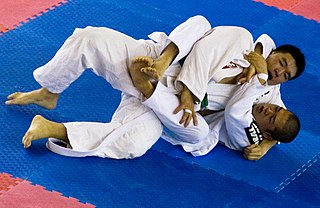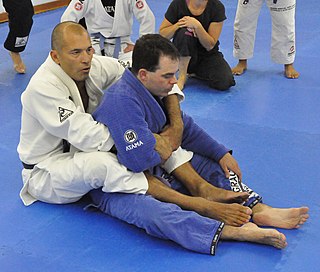
Brazilian jiu-jitsu is a self-defence, martial art and combat sport based on grappling, ground fighting, and submission holds. BJJ approaches self-defense by emphasizing taking an opponent to the ground, gaining a dominant position, and using a number of techniques to force them into submission via joint locks or chokeholds.
Professional wrestling throws are the application of professional wrestling techniques that involve lifting the opponent up and throwing or slamming them down. They are sometimes also called "power" maneuvers, as they are meant to emphasize a wrestler's strength. Many of these moves are used as finishers by various wrestlers, who refer to them by several different names that reflect their gimmick. Moves are listed under general categories whenever possible.
Professional wrestling holds include a number of set moves and pins used by performers to immobilize their opponents or lead to a submission. This article covers the various pins, stretches and transition holds used in the ring. Some wrestlers use these holds as their finishing maneuvers, often nicknaming them to reflect their character or persona. Moves are listed under general categories whenever possible.
A suplex is an offensive move used in sport wrestling as well as amateur wrestling and professional wrestling. It is a throw that involves lifting the opponents and bridging or rolling to slam them on their backs.
Strikes can be offensive moves in professional wrestling, that can sometimes be used to set up an opponent for a hold or for a throw. There are a wide variety of strikes in pro wrestling, and many are known by several different names. Professional wrestlers frequently give their finishers new names. Occasionally, these names become popular and are used regardless of the wrestler performing the technique.

The guard is a ground grappling position in which one combatant has their back to the ground while attempting to control the other combatant using their legs. In pure grappling combat sports, the guard is considered an advantageous position, because the bottom combatant can attack with various joint locks and chokeholds, while the top combatant's priority is the transition into a more dominant position, a process known as passing the guard. In the sport of mixed martial arts, as well as hand-to-hand combat in general, it is possible to effectively strike from the top in the guard, even though the bottom combatant exerts some control. There are various types of guard, with their own advantages and disadvantages.

The Boston crab is a professional wrestling hold that typically starts with one wrestler lying in a supine position on the mat, with the other wrestler standing and facing them. It is a type of spinal lock where the wrestler hooks each of the opponent’s legs in one of their arms and then turns the opponent face-down, stepping over them in the process. The final position has the wrestler in a semi-sitting position and facing away from the opponent, with the opponent’s back and legs bent back toward their head. The original name for the maneuver was the Backbreaker, before that term became known for its current usage. In modern wrestling, the Boston crab is not treated as a lethal submission maneuver, even though it was considered a match-ending hold in the past.

A chokehold, choke, stranglehold or, in Judo, shime-waza is a general term for a grappling hold that critically reduces or prevents either air (choking) or blood (strangling) from passing through the neck of an opponent. The restriction may be of one or both and depends on the hold used and the reaction of the victim. While the time it takes for the choke to render an opponent unconscious varies depending on the type of choke, the average across all has been recorded as 9 seconds.

Backbreaker refers to a kind of professional wrestling move which sees a wrestler dropping an opponent so that the opponent's back impacts or is bent backwards against a part of the wrestler's body, usually the knee. The standard version of the move sees the wrestler scoop their opponent horizontally before dropping to one knee, slamming the opponent's back on their other knee.

The rear naked choke (RNC) is a chokehold in martial arts applied from an opponent's back. The word "naked" in this context suggests that, unlike other strangulation techniques found in jujutsu/judo, this hold does not require the use of a keikogi ("gi") or training uniform.

The guillotine choke, also known as Mae Hadaka Jime in judo, is a chokehold in martial arts applied from in front of the opponent, often on the ground but can also be done while standing. The choke involves using the arms to encircle the opponent's neck that bears a resemblance to the blade of a guillotine.
An armlock in grappling is a single or double joint lock that hyperextends, hyperflexes or hyperrotates the elbow joint or shoulder joint. An armlock that hyper-extends the elbow is known as an armbar, and it includes the traditional armbar, the shoulder triangle armbar, and the shotgun armbar. An armlock that hyper-rotates the arm is known as an armcoil, and includes the americana, kimura, and omaplata. Depending on the joint flexibility of a person, armcoils can either hyper-rotate only the shoulder joint, only the elbow joint, or both the elbow joint and shoulder joint.

The mount, or mounted position, is a dominant ground grappling position, where one combatant sits on the other combatants torso with the face pointing towards the opponent's head. This is a favorable position for the top combatant in several ways. The top combatant can generate considerable momentum for strikes to the head of the opponent, while the bottom combatant is restricted by the ground and by the combatant on top. Other advantages include various chokeholds and joint locks that can be applied from the top. The bottom combatant will usually look to sweep the opponent or transition into a better position such as the guard.
Back mount, or rear mount, is a dominant grappling position where the practitioner is on their opponent's back in such a way that they have control of their opponent. Ideally, the opponent will be recumbent (prone), while the practitioner centers their weight atop the opponent, either in a seated or recumbent posture. Many consider back mount to be a very dominant, perhaps even the most advantageous position in grappling. This is due to the practitioner being able to attack with strikes and submissions with the opponent having a severely limited ability to see incoming attacks and defend against them.

In grappling, side control is a dominant ground grappling position where the top combatant is lying perpendicularly over the face-up bottom combatant in such a way that the legs are free and he or she exerts no control over the combatant on the bottom. The top combatant is referred to as having side control, and is in a stable position, with the other combatant pinned beneath them. From there the top combatant can proceed with elbows, knees, various submissions, or transition into a mounted position. It is high priority for the bottom combatant to sweep the top combatant or otherwise escape the position, for instance by entangling the opponent's free legs and trying to obtain the half guard or guard.

A nelson hold is a grappling hold which is executed by one person from behind the opponent, generally when both are on the mat face down with the opponent under the aggressor. One or both arms are used to encircle the opponent's arm under the armpit, and secured at the opponent's neck. Several different nelson holds exist, and they can be separated according to the positioning of the encircling arm(s). A nelson is used to control an opponent or to turn them over onto their back and execute a pin.

A grappling hold, commonly referred to simply as a hold that in Japanese is referred to as katame-waza, is any specific grappling, wrestling, judo, or other martial art grip that is applied to an opponent. Grappling holds are used principally to control the opponent and to advance in points or positioning. The holds may be categorized by their function, such as clinching, pinning, or submission, while others can be classified by their anatomical effect: chokehold, headlock, joint-lock, or compression lock. Multiple categories may be appropriate for some of these holds.

In combat sports, a spinal lock is a multiple joint lock applied to the spinal column, which is performed by forcing the spine beyond its normal ranges of motion. This is typically done by bending or twisting the head or upper body into abnormal positions. Commonly, spinal locks might strain the spinal musculature or result in a mild spinal sprain, while a forcefully and/or suddenly applied spinal lock may cause severe ligament damage or damage to the vertebrae, and possibly result in serious spinal cord injury, stroke, or death. Spinal locks and cervical locks are forbidden in IBJJF Brazilian jiu-jitsu competitions, amateur mixed martial arts (MMA), multiple forms of no Gi jiu-jitsu, judo, and other martial arts. However, professional MMA and some Brazilian jiu-jitsu competitions do permit spinal locks and, particularly, neck cranks, and such moves are trained in various MMA and Brazilian jiu-jitsu schools.

A pin is a predicament in wrestling that ends a match regardless of when it occurs. Some situations that near pins but do not meet the criteria, such as having only one shoulder down or having the defending wrestler blocked in a neck bridge, are rewarded with exposure points known as near fall points or back points.

Hooks is a term in grappling martial arts that generally refers to the use of careful positioning of a practitioner’s feet and legs to control and manipulate the movement or position of their opponent. One of the most common uses of hooks is in the back control position to prevent escape. However, a practitioner may alternatively use hooks to defend, sweep, or attack their opponent.














